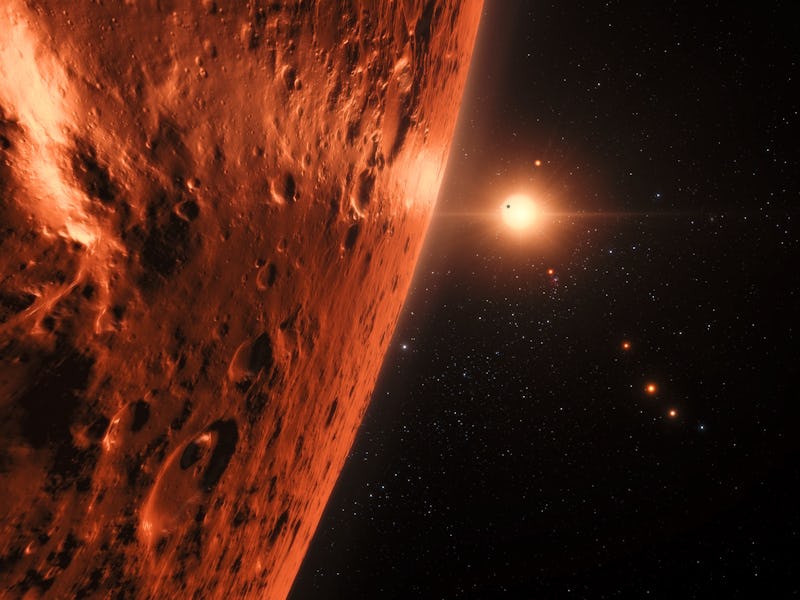TRAPPIST-1 Discovery Gives Exoplanet Research a Giant Leap Forward

The question “are we alone out there?” seeps and permeates pretty much every facet of space science. The unyielding drive to find an answer and learn whether or not life exists outside of Earth is what keeps humans in the exploration of the vacuum beyond the planet’s atmosphere. So naturally, whenever NASA holds a press conference that promises to reveal some new discovery, the world anxiously hopes we’ll finally get a positive answer that we’re not alone.
Unfortunately, that wasn’t what happened Wednesday, when scientists discussed the discovery of seven Earth-sized planets orbiting a star called TRAPPIST-1, 40 light-years away — a huge distance, sure, but just a stone’s throw relative to the cosmos. What the announcement did do, however, was emphasize how much progress humans have made towards answering that question, and underscore the fact that we’re closer than ever to learning if there’s life on other worlds.
After all, we’re talking about a staggering seven exoplanets in a single star system — unheard of outside the solar system. “Just imagine how many worlds out there have a shot to becoming a habitable system,” Thomas Zurbuchen, associate administrator of the Science Mission Directorate at NASA, said at the conference. “Finding a second Earth” — a world that may not simply host alien life, but could also be a home for future generations of humans who have mastered interstellar travel — “is not just a matter of if, but when.”
The field wasn’t always in such a positive mood. As Sara Seager, an astrophysicist at MIT, told the audience, exoplanet research just a mere 20 years ago was dismissed as “stamp-collecting” by the vast majority of the scientific community. The tools and instruments to observe stars that closely and determine if they had planets — and what those planets looked like — simply hadn’t been invented yet.
Fast forward to today, and we have 3,500 confirmed exoplanets, including 44 potentially habitable worlds (not counting the new TRAPPIST findings).
Artist’s impression of TRAPPIST-1 and its planets reflected in a surface.
The trove of exoplanets just announced is more consequential than simply raising hopes one of them is Earth 2.0. Each one provides an opportunity to “test many people’s theories about this world,” said Seager. “Goldilocks has many sisters … we have many chances over to figure out if one of these worlds is indeed habitable.”
For Sean Carey, the manager of NASA’s Spitzer Science Center in Pasadena, California, the findings add more value to NASA’s Spitzer Space Telescope — a tool that is quickly proving to be invaluable in exoplanet research. “This is the most exciting discovery we’ve had yet” in all of Spitzer’s years, said Carey. The telescope was “never intended to study exoplanets,” and yet it’s assisted in one of the biggest exoplanet discoveries ever, thanks to its great capabilities in observing infrared light. “It’s very gratifying.”
Meanwhile, the biggest obstacle that prevents the space community from really celebrating TRAPPIST-1 is that, while we know the planets have the potential to host life — which really means they have the potential to possess liquid surface water — no one knows for sure if it can. There’s very little we know about the atmospheric conditions on the planets that would actually allow for organic life to evolve. Nikole Lewis, an astronomer at the Space Telescope Science Institute in Baltimore, is eager to follow-up with those specific investigative goals, and calls TRAPPIST-1 “a great opportunity to study Earth-sized atmosphere in greater detail.”
Ultimately, TRAPPIST-1 is just one of what is bound to be many more critical discoveries in the world of exoplanets and extraterrestrial habitability. “This is a search that will go on for many generations,” said Seager.